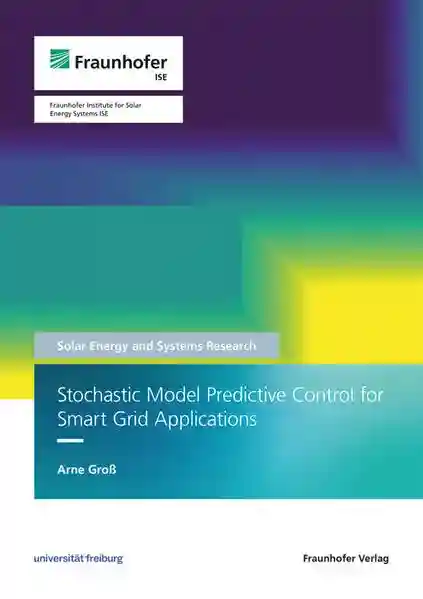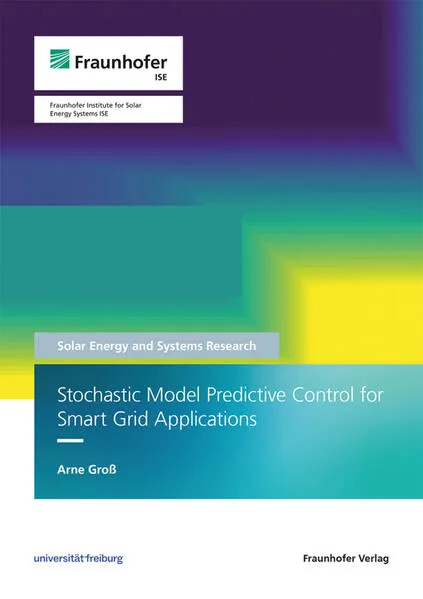Solare Energie- und Systemforschung / Solar Energy and Systems Research
Stochastic Model Predictive Control for Smart Grid Applications
Chronologie aller Bände (1 - 2)

Die Reihenfolge beginnt mit dem Buch "Stochastic Model Predictive Control for Smart Grid Applications". Wer alle Bücher der Reihe nach lesen möchte, sollte mit diesem Band von Arne Groß beginnen. Der zweite Teil der Reihe "Development and Characterization of Resource-saving Doping Processes for Industrial Silicon Solar Cells" ist am 07.12.2023 erschienen. Die Reihe umfasst derzeit 2 Bände. Der neueste Band trägt den Titel "Development and Characterization of Resource-saving Doping Processes for Industrial Silicon Solar Cells".
- Anzahl der Bewertungen für die gesamte Reihe: 0
- Ø Bewertung der Reihe: 0
Diese Reihenfolge enthält 2 unterschiedliche Autoren.
- Autor: Groß, Arne
- Anzahl Bewertungen: 0
- Ø Bewertung:
- Medium: Buch
- Veröffentlicht: 23.11.2023
- Genre: Sonstiges
Stochastic Model Predictive Control for Smart Grid Applications
A high share of renewables in the energy sector introduces volatility and forecast uncertainty on the generation side of the electricity system. These uncertainties are mitigated using storage systems. An example of such storage systems are residential photovoltaic battery systems that operate in an increasingly complex economic and regulatory environment.
This thesis investigates model predictive control of such systems. Therein, external and historic data is used to model forecast uncertainty of household load as well as photovoltaic generation.This leads to stochastic optimal control problems which are solved using stochastic dynamic programming. With this approach, the nonlinear and discrete dynamics of the controlled system can be modeled without significant increase in computational requirements.The control scheme was applied to two cases in simulation and field test. In both cases the stochastic modelling yielded better performance than a comparable state of the art control scheme.
This thesis investigates model predictive control of such systems. Therein, external and historic data is used to model forecast uncertainty of household load as well as photovoltaic generation.This leads to stochastic optimal control problems which are solved using stochastic dynamic programming. With this approach, the nonlinear and discrete dynamics of the controlled system can be modeled without significant increase in computational requirements.The control scheme was applied to two cases in simulation and field test. In both cases the stochastic modelling yielded better performance than a comparable state of the art control scheme.
- Autor: Meßmer, Marius
- Anzahl Bewertungen: 0
- Ø Bewertung:
- Medium: Buch
- Veröffentlicht: 07.12.2023
- Genre: Sonstiges
Development and Characterization of Resource-saving Doping Processes for Industrial Silicon Solar Cells
In this dissertation, high throughput approaches for diffusion and oxidation processes for silicon solar cell manufacturing are investigated. The focus lies on developing sustainable processes or process combinations for PERC and TOPCon solar cells which enable higher throughputs and reduced energy consumption than state-of-the-art processes at comparable energy conversion efficiency level.
High throughput is reached by increasing the wafer load in the process using wafer stacks, where the wafer surfaces are touching each other. The interactions between phosphorus diffusion and thermal oxidation of the stack process approach are examined in detail. Further, a hypothesis for the oxygen gas transport mechanism into the wafer gap is stated and confirmed by experiments and simulation. Further understanding of the stack diffusion approach is generated when investigating boron-doping processes.
High throughput is reached by increasing the wafer load in the process using wafer stacks, where the wafer surfaces are touching each other. The interactions between phosphorus diffusion and thermal oxidation of the stack process approach are examined in detail. Further, a hypothesis for the oxygen gas transport mechanism into the wafer gap is stated and confirmed by experiments and simulation. Further understanding of the stack diffusion approach is generated when investigating boron-doping processes.
